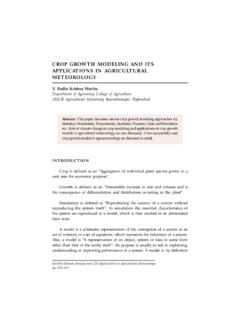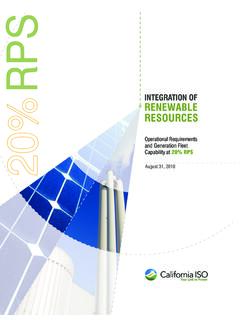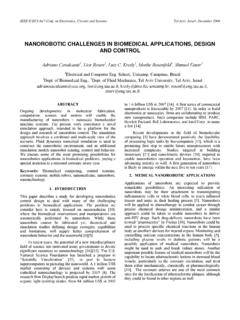Transcription of General Morphological Analysis - Swedish …
1 Swedish Morphological Society 2002 (revised 2013) General Morphological Analysis * A General method for non-quantified modelling Tom Ritchey Swedish Morphological Society Fritz Zwicky pioneered the development of General Morphological Analysis (GMA) as a method for investigating the totality of relationships contained in multi-dimensional, non-quantifiable problem complexes. During the past two decades, GMA has been computerised, extended and employed for structuring complex policy and planning issues, developing scenario and strategy laboratories, and analyzing organizational and stakeholder structures. This article outlines the fundamentals of the Morphological approach and describes an application in policy Analysis . Keywords General Morphological Analysis , Morphological modelling, typology Analysis , Fritz Zwicky, non-quantified modelling, policy Analysis .
2 Within the final and true world image everything is related to everything, and nothing can be discarded a priori as being unimportant. (Fritz Zwicky: Discovery, Invention, Research through the Morphological Approach.) INTRODUCTION General Morphological Analysis (GMA) was developed by Fritz Zwicky the Swiss astro-physicist and aerospace scientist based at the California Institute of Technology (Caltech) as a method for structuring and investigating the total set of relationships contained in multi-dimensional, non-quantifiable, problem complexes (Zwicky 1966, 1969). Zwicky applied this method to such diverse fields as the classification of astrophysical objects, the development of jet and rocket propulsion systems, and the legal aspects of space travel and colonization. He founded the Society for Morphological Research and advanced the " Morphological approach" for some 30 years, between the 1940's until his death in 1974.
3 More recently, GMA has been applied by a number of researchers in the USA and Europe in the fields of policy Analysis and futures studies ( Godet, 1994; Rhyne 1995; Coyle & McGlone, 1995; Ritchey 1997). In 1995, advanced computer support for GMA was developed at the Swedish Defence Research Agency (for a description, see Ritchey, 2003b). This has made it possible to create interactive, non-quantified inference models, which significantly extends GMA's functionality and areas of application (Ritchey 1998-2011). Since then, more than 100 projects have been carried out using computer aided Morphological Analysis , for structuring complex policy and planning issues, developing scenario and strategy laboratories, and analyzing organizational and stakeholder structures. * Adapted from the paper "Fritz Zwicky, Morphologie and Policy Analysis ", presented at the 16th EURO Conference on Operational Analysis , Brussels, 1998.
4 Contact: T. Ritchey: General Morphological Analysis _____ 2 This article will begin with a discussion of some of the methodological problems confronting complex, non-quantified modelling, especially as applied to policy Analysis and futures studies. This is followed by a presentation of the fundamentals of the Morphological approach along with a recent application to policy Analysis . METHODOLOGICAL BACKGROUND Analysing complex policy fields and developing futures scenarios presents us with a number of difficult methodological problems. Firstly, many, if not all of the factors involved are non-quantifiable, since they contain strong social-political dimensions and conscious self-reference among actors. This means that traditional quantitative methods, causal modelling and simulation are relatively useless.
5 Secondly, the uncertainties inherent in such problem complexes are in principle non-reducible, and often cannot be fully described or delineated. This represents even a greater blow to the idea of causal modelling and simulation. Finally, the actual process by which conclusions are drawn in such studies is often difficult to trace we seldom have an adequate audit trail describing the process of getting from initial problem formulation to specific solutions or conclusions. Without some form of traceability we have little possibility of scientific control over results, let alone reproducibility. An alternative to formal (mathematical) methods and causal modelling is a form of non-quantified modelling relying on judgmental processes and internal consistency, rather than causality. Causal modelling, when applicable, can and should be used as an aid to judgement.
6 However, at a certain level of complexity ( at the social, political and cognitive level), judgement must often be used -- and worked with -- more or less directly. The question is: How can judgmental processes be put on a sound methodological basis? Historically, scientific knowledge develops through cycles of Analysis and synthesis: every synthesis is built upon the results of a proceeding Analysis , and every Analysis requires a subsequent synthesis in order to verify and correct its results (Ritchey 1991, 2012). However, Analysis and synthesis as basic scientific methods say nothing about a problem having to be quantifiable. Complex social-political problem fields can be analysed into any number of non-quantified variables and ranges of conditions. Similarly, sets of non-quantified conditions can be synthesised into well-defined relationships or configurations, which represent solution spaces.
7 In this context, there is no fundamental difference between quantified and non-quantified modelling. General MORPHOLOGY The term morphology comes from antique Greek (morphe) and means shape or form. The General definition of morphology is "the study of form or pattern", the shape and arrangement of parts of an object, and how these "conform" to create a whole or Gestalt. The "objects" in question can be physical objects ( an organism, a geography or an ecology), social objects (an organisation or other social system) or mental objects ( linguistic forms, concepts or systems of ideas). T. Ritchey: General Morphological Analysis _____ 3 The first to use the term morphology as an explicitly defined scientific method would seem to be J. W. von Goethe (1749-1832), especially in his "comparative morphology" in botany.
8 Today, morphology is associated with a number of scientific disciplines in which formal structure, and not primarily quantity, is a central issue. In linguistics, it is the study of word formation; in biology, it deals with the form and structure of organisms; in geology it concerns the characteristics, configuration and evolution of rocks and land forms. Fritz Zwicky proposed a generalised form of Morphological research: Attention has been called to the fact that the term morphology has long been used in many fields of science to designate research on structural interrelations for instance in anatomy, geology, botany and biology.. I have proposed to generalize and systematize the concept of Morphological research and include not only the study of the shapes of geometrical, geological, biological, and generally material structures, but also to study the more abstract structural interrelations among phenomena, concepts, and ideas, whatever their character might be.
9 (Zwicky, 1966, p. 34) Essentially, General Morphological Analysis is a method for identifying and investigating the total set of possible relationships or configurations contained in a given problem complex. In this sense, it is closely related to typology Analysis , although GMA is more generalised in form and has far broader applications. (A brief history of Morphological methods is presented in Ritchey, 2006a.) The approach begins by identifying and defining the parameters (or dimensions) of the problem complex to be investigated, and assigning each parameter a range of relevant values or conditions. A Morphological box also fittingly known as a Zwicky box is constructed by setting the parameters against each other in an n-dimensional matrix (see Figure 1a). Each cell of the n-dimensional box contains one particular value or condition from each of the parameters, and thus marks out a particular state or configuration of the problem complex.
10 For example, imagine a simple problem complex, which we define as consisting of three dimensions let us say colour , texture and size . In order to conform to Figure 1a, let us further define the first two dimensions as consisting of 5 discrete values or conditions each ( colour = red, green, blue, yellow, brown) and the third consisting of 3 values (size = large, medium, small) . We then have 5x5x3 (= 75) cells in the Zwicky box, each containing 3 conditions one from each dimension ( red, rough, large). The entire 3-dimensional matrix is a typological field containing all of the (formally) possible relationships involved. The typological field format utilizes the dimensions of physical space to represent its variables, as in a Cartesian coordinate system. However, the number of coordinates that can be represented in physical space ends at three.











